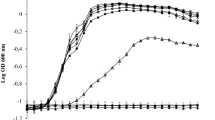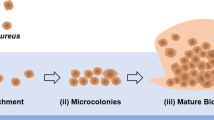Abstract
The present study investigated and compared the effect of growth temperature on the susceptibility of biofilm-detached and planktonic Staphylococcus aureus cells, to benzalkonium chloride (BAC). This study also highlights the impact of BAC on the bacterial physiology and the role of membrane fluidity regulation as a bacterial resistance mechanism. The minimum inhibitory concentration of BAC was characterized with micro-dilution growth inhibition assay. The BAC treatment was performed on S. aureus cultured at 20 °C and 37 °C, for 24 h. The morphology of S. aureus cells was examined using scanning electron microscopy. The loss of bacterial membrane integrity after BAC treatment was studied by monitoring the intracellular potassium ion leakage using the atomic absorption spectroscopy. The bacterial membrane total fatty acid composition, controlling the membrane fluidity, was analyzed by GC/MS. The results showed that the resistance of S. aureus cells to BAC increased with the increase of growth temperature. The planktonic cells were more susceptible to BAC than biofilm-detached ones. The rise of growth temperature resulted in an increase of S. aureus membrane rigidity. Furthermore, a higher membrane fluidity was observed in planktonic cells when compared to that in the biofilm-detached ones. The resistance of S. aureus seems to depend on the growth temperature. Compared to planktonic cells, biofilm-detached cells showed a greater resistance to BAC. The BAC targets and disturbs the bacterial membrane. Membrane fluidity modulation is likely a one of resistance mechanisms for S. aureus to BAC at the cellular scale. Therefore, disinfection procedures, in food sector, should be adapted for bacteria detached from biofilm.





Similar content being viewed by others
References
Abdallah M, Chataigne G, Ferreira-Theret P et al (2014) Effect of growth temperature, surface type and incubation time on the resistance of Staphylococcus aureus biofilms to disinfectants. Appl Microbiol Biotechnol 98:2597–2607. https://doi.org/10.1007/s00253-013-5479-4
Abdallah M, Benoliel C, Ferreira-Theret P et al (2015) Effect of culture conditions on the resistance of Pseudomonas aeruginosa biofilms to disinfecting agents. Biofouling 31:49–59. https://doi.org/10.1080/08927014.2014.993390
Annous BA, Becker LA, Bayles DO et al (1997) Critical role of anteiso-C15:0 fatty acid in the growth of Listeria monocytogenes at low temperatures. Appl Environ Microbiol 63:3887–3894
Batoni G, Maisetta G, Esin S (2016) Antimicrobial peptides and their interaction with biofilms of medically relevant bacteria. Antimicrob Pept Cell Membr Microb Surf Interact 1858:1044–1060. https://doi.org/10.1016/j.bbamem.2015.10.013
Berne C, Ellison CK, Ducret A, Brun YV (2018) Bacterial adhesion at the single-cell level. Nat Rev Microbiol. https://doi.org/10.1038/s41579-018-0057-5
Bridier A, Briandet R, Thomas V, Dubois-Brissonnet F (2011) Resistance of bacterial biofilms to disinfectants: a review. Biofouling 27:1017–1032. https://doi.org/10.1080/08927014.2011.626899
Chihib N-E, Tierny Y, Mary P, Hornez JP (2005) Adaptational changes in cellular fatty acid branching and unsaturation of Aeromonas species as a response to growth temperature and salinity. Int J Food Microbiol 102:113–119. https://doi.org/10.1016/j.ijfoodmicro.2004.12.005
Chua SL, Liu Y, Yam JKH et al (2014) Dispersed cells represent a distinct stage in the transition from bacterial biofilm to planktonic lifestyles. Nat Commun 5:4462
Davies D (2003) Understanding biofilm resistance to antibacterial agents. Nat Rev Drug Discov 2:114–122. https://doi.org/10.1038/nrd1008
Denayer S, Delbrassinne L, Nia Y, Botteldoorn N (2017) Food-borne outbreak investigation and molecular typing: high diversity of Staphylococcus aureus strains and importance of toxin detection. Toxins 9:407. https://doi.org/10.3390/toxins9120407
Dubois-Brissonnet F, Trotier E, Briandet R (2016) The biofilm lifestyle involves an increase in bacterial membrane saturated fatty acids. Front Microbiol 7:1673. https://doi.org/10.3389/fmicb.2016.01673
Gilbert P, Moore LE (2005) Cationic antiseptics: diversity of action under a common epithet. J Appl Microbiol 99:703–715. https://doi.org/10.1111/j.1365-2672.2005.02664.x
Kadariya J, Smith TC, Thapaliya D (2014) Staphylococcus aureus and staphylococcal food-borne disease: an ongoing challenge in public health. Biomed Res Int 2014:9
Kaneda T (1991) Iso- and anteiso-fatty acids in bacteria: biosynthesis, function, and taxonomic significance. Microbiol Rev 55:288–302
Khelissa SO, Abdallah M, Jama C et al (2017a) Bacterial contamination and biofilm formation on abiotic surfaces and strategies to overcome their persistence. J Mater Environ Sci 8:3326–3346
Khelissa SO, Jama C, Abdallah M et al (2017b) Effect of incubation duration, growth temperature, and abiotic surface type on cell surface properties, adhesion and pathogenicity of biofilm-detached Staphylococcus aureus cells. AMB Express 7:191. https://doi.org/10.1186/s13568-017-0492-0
Malanovic N, Lohner K (2016) Antimicrobial peptides targeting gram-positive bacteria. Pharmaceuticals 9:59. https://doi.org/10.3390/ph9030059
Rollet C, Gal L, Guzzo J (2009) Biofilm-detached cells, a transition from a sessile to a planktonic phenotype: a comparative study of adhesion and physiological characteristics in Pseudomonas aeruginosa. FEMS Microbiol Lett 290:135–142. https://doi.org/10.1111/j.1574-6968.2008.01415.x
Schindler H (1980) Introduction to biological membranes. Trends Neurosci 3:XXII. https://doi.org/10.1016/S0166-2236(80)80081-6
Simões M, Simões LC, Vieira MJ (2010) A review of current and emergent biofilm control strategies. LWT Food Sci Technol 43:573–583. https://doi.org/10.1016/j.lwt.2009.12.008
Suutari M, Laakso S (1994) Microbial fatty acids and thermal adaptation. Crit Rev Microbiol 20:285–328. https://doi.org/10.3109/10408419409113560
Tuson HH, Weibel DB (2013) Bacteria-surface interactions. Soft Matter 9:4368–4380. https://doi.org/10.1039/C3SM27705D
Wang L-H, Wang M-S, Zeng X-A, Liu Z-W (2016) Temperature-mediated variations in cellular membrane fatty acid composition of Staphylococcus aureus in resistance to pulsed electric fields. Biochim Biophys Acta BBA Biomembr 1858:1791–1800. https://doi.org/10.1016/j.bbamem.2016.05.003
Zhang Y-M, Rock CO (2008) Membrane lipid homeostasis in bacteria. Nat Rev Microbiol 6:222–233. https://doi.org/10.1038/nrmicro1839
Acknowledgements
The authors thank the Haut de France region and FEDER (Fonds européen de développement régional) for their financial support.
Funding
This work was carried out within the framework of ALIBIOTECH (Agroalimentaire et Biotechnologie, Nord Pas-de-Calais region) program.
Author information
Authors and Affiliations
Corresponding author
Ethics declarations
Conflict of interest
The authors declare that they have no conflict of interest.
Research involving human participants and/or animals
This article does not contain any studies with human participants or animals performed by any of the authors.
Informed consent
N/A
Additional information
Publisher’s Note
Springer Nature remains neutral with regard to jurisdictional claims in published maps and institutional affiliations.
Rights and permissions
About this article
Cite this article
Khelissa, S.O., Abdallah, M., Jama, C. et al. Comparative study of growth temperature impact on the susceptibility of biofilm-detached and planktonic Staphylococcus aureus cells to benzalkonium chloride. Ann Microbiol 69, 291–298 (2019). https://doi.org/10.1007/s13213-018-1419-y
Received:
Accepted:
Published:
Issue Date:
DOI: https://doi.org/10.1007/s13213-018-1419-y




